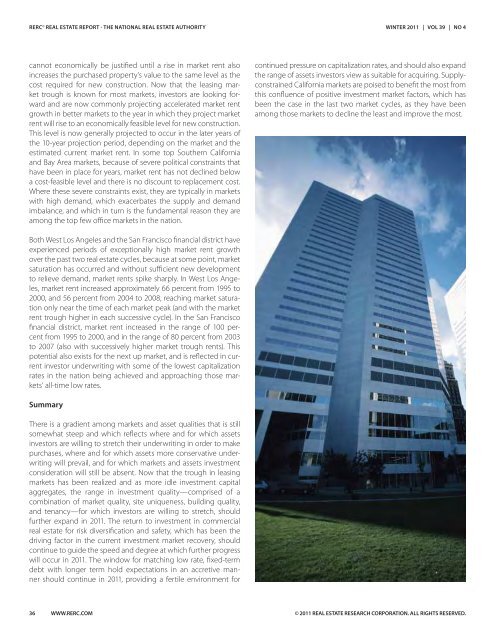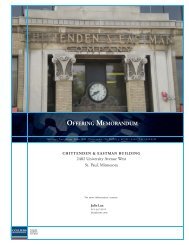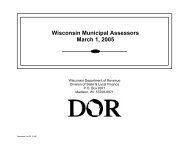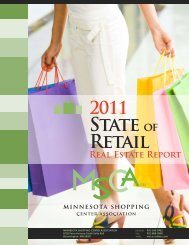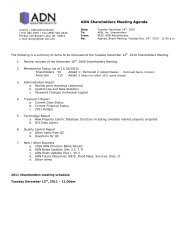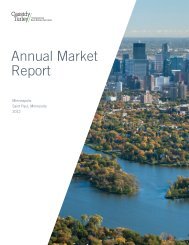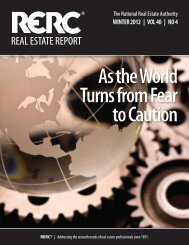REAL ESTATE REPORT - REDI-net.com
REAL ESTATE REPORT - REDI-net.com
REAL ESTATE REPORT - REDI-net.com
- TAGS
- real
- estate
- redi-net.com
Create successful ePaper yourself
Turn your PDF publications into a flip-book with our unique Google optimized e-Paper software.
RERC © <strong>REAL</strong> <strong>ESTATE</strong> <strong>REPORT</strong> - THE NATIONAL <strong>REAL</strong> <strong>ESTATE</strong> AUTHORITY<br />
cannot economically be justified until a rise in market rent also<br />
increases the purchased property’s value to the same level as the<br />
cost required for new construction. Now that the leasing market<br />
trough is known for most markets, investors are looking forward<br />
and are now <strong>com</strong>monly projecting accelerated market rent<br />
growth in better markets to the year in which they project market<br />
rent will rise to an economically feasible level for new construction.<br />
This level is now generally projected to occur in the later years of<br />
the 10-year projection period, depending on the market and the<br />
estimated current market rent. In some top Southern California<br />
and Bay Area markets, because of severe political constraints that<br />
have been in place for years, market rent has not declined below<br />
a cost-feasible level and there is no discount to replacement cost.<br />
Where these severe constraints exist, they are typically in markets<br />
with high demand, which exacerbates the supply and demand<br />
imbalance, and which in turn is the fundamental reason they are<br />
among the top few office markets in the nation.<br />
Both West Los Angeles and the San Francisco financial district have<br />
experienced periods of exceptionally high market rent growth<br />
over the past two real estate cycles, because at some point, market<br />
saturation has occurred and without sufficient new development<br />
to relieve demand, market rents spike sharply. In West Los Angeles,<br />
market rent increased approximately 66 percent from 1995 to<br />
2000, and 56 percent from 2004 to 2008, reaching market saturation<br />
only near the time of each market peak (and with the market<br />
rent trough higher in each successive cycle). In the San Francisco<br />
financial district, market rent increased in the range of 100 percent<br />
from 1995 to 2000, and in the range of 80 percent from 2003<br />
to 2007 (also with successively higher market trough rents). This<br />
potential also exists for the next up market, and is reflected in current<br />
investor underwriting with some of the lowest capitalization<br />
rates in the nation being achieved and approaching those markets’<br />
all-time low rates.<br />
Summary<br />
There is a gradient among markets and asset qualities that is still<br />
somewhat steep and which reflects where and for which assets<br />
investors are willing to stretch their underwriting in order to make<br />
purchases, where and for which assets more conservative underwriting<br />
will prevail, and for which markets and assets investment<br />
consideration will still be absent. Now that the trough in leasing<br />
markets has been realized and as more idle investment capital<br />
aggregates, the range in investment quality—<strong>com</strong>prised of a<br />
<strong>com</strong>bination of market quality, site uniqueness, building quality,<br />
and tenancy—for which investors are willing to stretch, should<br />
further expand in 2011. The return to investment in <strong>com</strong>mercial<br />
real estate for risk diversification and safety, which has been the<br />
driving factor in the current investment market recovery, should<br />
continue to guide the speed and degree at which further progress<br />
will occur in 2011. The window for matching low rate, fixed-term<br />
debt with longer term hold expectations in an accretive manner<br />
should continue in 2011, providing a fertile environment for<br />
36 WWW.RERC.COM<br />
WINTER 2011 | VOL 39 | NO 4<br />
continued pressure on capitalization rates, and should also expand<br />
the range of assets investors view as suitable for acquiring. Supplyconstrained<br />
California markets are poised to benefit the most from<br />
this confluence of positive investment market factors, which has<br />
been the case in the last two market cycles, as they have been<br />
among those markets to decline the least and improve the most.<br />
© 2011 <strong>REAL</strong> <strong>ESTATE</strong> RESEARCH CORPORATION. ALL RIGHTS RESERVED.


